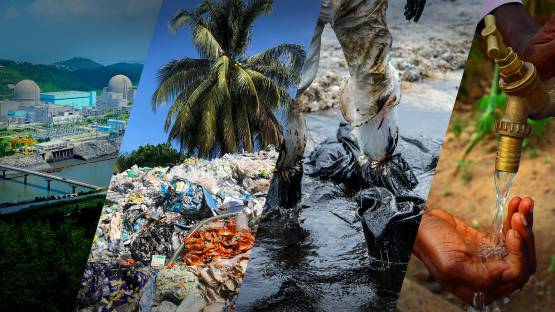
Today is World Environment Day, the international day calling for collective, transformative action on a global scale to celebrate, protect, and restore our planet. For too long human activities have over extracted from and polluted natural environments, and the consequences have been dire: out-of-control climate change, massive biodiversity loss, the emergence and spread of new diseases. However, hope is not lost and solutions exists that can remedy the damage caused and set our planet on a path towards recovery — some of these solutions rely on nuclear science.
Here are just four ways in which nuclear science and technology is playing an important role in protecting, conserving, and restoring our environment.
1. Mitigating climate change

Climate change is one of the biggest challenges facing humanity and it’s driven — to a great extent — by carbon emissions from burning fossil fuels. Reducing and ultimately ending these emissions requires an enormous, concerted effort by governments, industry and citizens to cut our reliance on fossil fuels and transition to low-carbon energy sources such as renewables and nuclear power.
Nuclear power accounts for roughly 10 per cent of the world’s electricity and over a quarter of its low-carbon electricity. When generating electricity, a nuclear power plant produces almost no carbon emissions — listen to our podcast to find out more — and so can play a key role in the transition to a low-emission energy future. The IAEA supports countries pursuing nuclear power programmes and has produced a trove of knowledge on how nuclear power can contribute towards decarbonisation and timely climate action. Recently, the IAEA launched an initiative to fast-track the development of hydrogen from nuclear to help decarbonise the most challenging fossil fuel-reliant sectors, such as heavy industry and transport.
2. Recycling plastic pollution

Since 1950, over eight billion tonnes of plastic have been produced. Plastic pollution has become one of today’s most pressing global environmental challenges, both on land and at sea where it chokes animals and seabirds and has begun to enter food webs. Not nearly enough of plastic is recycled or can be recycled using conventional methods, so the IAEA is working with countries to find solutions with the help of radiation technologies.
Last year the IAEA launched NUTEC Plastics, an initiative that supports using specialized nuclear methods to precisely track and quantify the movement and impacts of microplastic particles and associated co-contaminants in the environment — allowing experts to determine the status and trends of marine plastics, assess their impact on marine animals, and develop risk scenarios for informed decision making.
The initiative is also helping to make more plastics recyclable. Using radiation processes such as cross-linking, chain scission, grafting and other surface modifications, experts can help turn previously unrecyclable plastics into recyclable ones. Check out our recent photo essay on using irradiation towards a circular economy too learn more about the use of this technology in the Philippines.
3. Monitoring environmental pollution

Many activities in the modern world release pollutants into the environment. Pollution in the air, water, or soil impact and become a part of biological, geological and chemical cycles. Using nuclear techniques and tools, experts can study these processes to deal with pollutants and contaminated sites.
In the air, isotopic and nuclear tools are used monitor the pathways of heavy metal, greenhouse gases, and radioactive gases and particles through the atmosphere. Here’s a video on how scientists are able to use stable isotopes to ‘fingerprint’ greenhouse gases present in a sample of air and trace it to its source.
On land, nuclear techniques can precisely identify and measure pollutants. Using such techniques, the IAEA assists countries with monitoring, modelling and assessments for environmental protection initiatives. Here’s an example of how the IAEA has trained scientists and experts from Africa in correctly collecting and pre-treating environmental samples for measurement of radioactivity.
At sea, cutting-edge nuclear and isotopic techniques can accurately monitor pollution, minimise the impact of incidents and mitigate their effect on local populations. In January, Peru experienced a major oil spill because of a tsunami from a distant earthquake in Tonga, and the IAEA sent a fact-finding expert mission to support the country’s efforts to clean up the spill and monitor its effects.
4. Managing freshwater resources

Human life depends on the availability of water. Making sure the water we extract for drinking, industry and agriculture is sustainable can be achieved by measuring ratios of isotopes in the water — a field of science called isotope hydrology.
The IAEA support countries through its isotope hydrology laboratory with the application of nuclear and isotopic techniques in all aspects of freshwater resource assessments and water management and protection. For example, in Zimbabwe the IAEA is helping experts use isotopic techniques to assess the interactions of their groundwater and river systems, so as to better manage their freshwater resources, cope with pollution, and ensure safe water supplies for people. In Bolivia, nuclear techniques are being used to monitor glacier retreat and the impact it has on wetlands.
To discover other nuclear techniques and technologies addressing environmental issues, visit our topic on the environment and stay informed by subscribing to our web newsletter and Facebook, LinkedIn, Twitter, Instagram accounts.
Taken from the site: https://www.iaea.org/